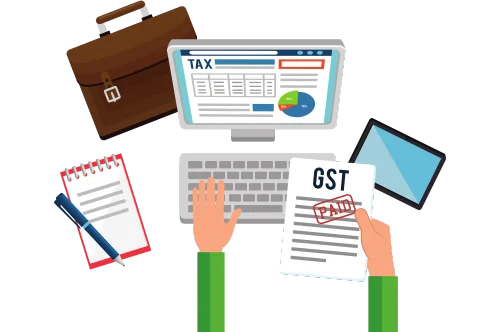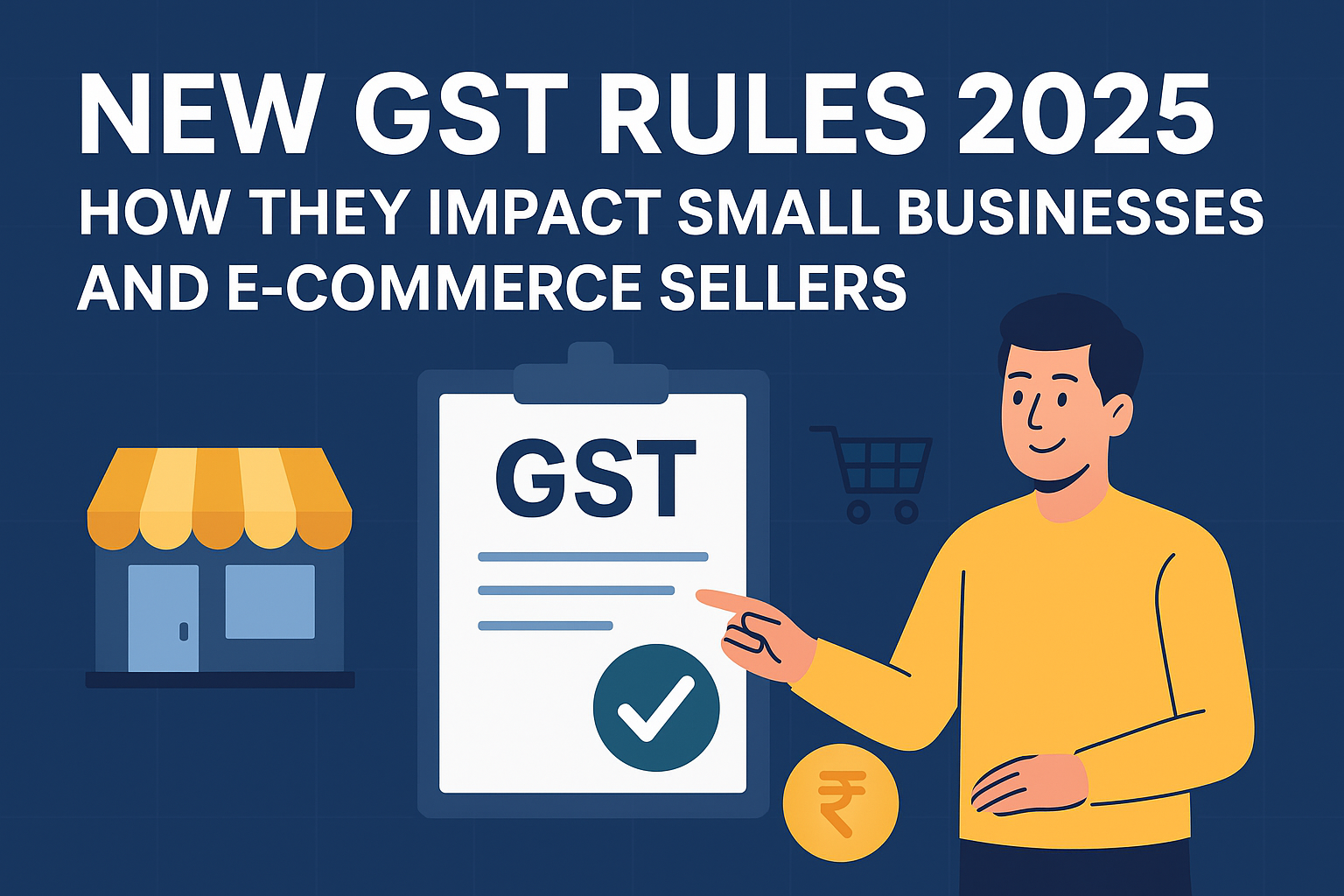Introduction
The business landscape in India is evolving fast, and the tax framework is no exception. With the introduction of the new GST rules 2025, small businesses and e-commerce sellers must pay close attention. These changes are not just technical tweaks—they can significantly affect cash flow, compliance cost, and growth strategy. In this blog, we examine the key aspects of the GST rules 2025, what they mean for small traders and online sellers, and how you can prepare proactively.
What are the GST Rules 2025?
When we talk about the GST rules 2025, we refer to a set of regulatory updates under the Goods and Services Tax (GST) regime in India which either become effective in 2025 or roll out in phases during that year. These include:
Stricter compliance requirements such as multi-factor authentication (MFA) for GST portal access. (India Briefing)
Tighter rules around e-way bills, e-invoicing thresholds and document age limits for goods movement. (ClearTax)
Specific rules for e-commerce sellers—especially regarding registration, tax collection at source (TCS), classification of goods and services, and place of supply norms. (Outlook Money)
Return filing and audit-related changes: deadlines, non-editable returns after submission, and three-year time-limit to file past returns. (India Briefing)
In short, the GST rules 2025 raise the bar for compliance and tighten the tax net in several ways. For small businesses and e-commerce sellers this means both challenges and opportunities.
Why Small Businesses & E-commerce Sellers Should Care
1. Increased Regulatory Burden
Under GST rules 2025, even smaller players can’t afford to ignore compliance. For example:
The requirement for GST registration for online sellers regardless of turnover is becoming stricter. (Outlook Money)
For e-commerce sellers, the TCS mechanism (1 % deduction by marketplaces) remains in force and must be claimed correctly. (ClearTax)
2. Cash Flow Implications
Compliance-driven changes like TCS, stricter e-invoicing, place of supply rules, or delayed input tax credits (ITC) directly impact business cash flows. If you don’t manage your GST obligations properly under the GST rules 2025, you may face blocked credits, delayed refunds, or added cost.
3. Competitive Advantage
On the flip side, businesses that adapt early to the GST rules 2025 may gain a competitive edge: fewer surprises, smooth compliance, better credibility with marketplaces and buyers. If you can turn compliance into a strength, that may help brand image and trust.
Key Changes Under the GST Rules 2025 & Their Impact
Here are some of the standout changes under the GST rules 2025 and how they impact small businesses and e-commerce sellers.
A. Multi-Factor Authentication (MFA) & Portal Security
From January/February 2025 onwards the GST portal is enforcing MFA for access for taxpayers with higher turnover and then gradually for others. (lawgicalindia.com)
Impact: Small businesses need to ensure their GST portal login credentials are secure, authorised personnel are trained, and systems are updated. Something as simple as losing access can delay filings or raise compliance risks.
B. E-Way Bill & E-Invoicing Restrictions
Under the GST rules 2025: An e-way bill can only be generated if the underlying document (invoice, debit note etc) is less than 180 days old. Extensions are limited to 360 days from the original e-way bill date. (India Briefing)
Also, the e-invoicing thresholds are being lowered, capturing more taxpayers. (India Briefing)
Impact: For goods transporters, logistics, and sellers shipping inter-state or even intra-state goods, these rules mean tighter control. Delay in invoicing or dispatch could mean you lose ability to generate e-way bill, incur penalties or face transit issues.
C. Return Filing & Non-Editability
According to the GST rules 2025, from July 1 2025 the returns (such as GSTR-3B) will become non-editable once filed. (India Briefing)
Impact: Small businesses must reconcile data diligently before filing. Errors can no longer be “fixed later” casually; delayed corrections can cause issues with ITC and mismatches.
D. E-commerce Specific Rules: Registration, TCS, Place of Supply
The requirement of GST registration for online sellers irrespective of turnover (in many cases). (Outlook Money)
E-commerce platforms collect TCS at 1 % on sales of the seller; the seller must claim it properly in returns. (ClearTax)
Stricter place of supply rules and IGST/CGST/SGST splits for inter-state sales under the GST rules 2025. (GST Invoice)
Impact: For e-commerce sellers, it’s imperative to map sales correctly, maintain records, classify HSN/SAC codes precisely, and integrate your invoicing and marketplace systems. Ignoring these can mean blocked ITC, mismatches, denial of refunds or even notices.
E. Rate Structure & Slab Changes
Though the specific rate cuts and slab restructuring (such as moving to a two-rate system) are major, for small business and e-commerce sellers the take-away is: ensure product classification, pricing, and systems are updated. (Vertex, Inc.)
Impact: If your product classification is wrong, or you fail to update your system for new GST rates, you may under-charge (leading to demand from tax authorities) or over-charge (losing competitiveness).
Practical Steps for Small Businesses & E-commerce Sellers
Given the scope of the GST rules 2025, here are some actionable steps you should take:
Update accounting/billing software
Make sure your software supports the latest HSN/SAC codes, e-invoicing APIs (if required), e-way bill integration, and supports the updated rules under GST rules 2025.Train your team
Especially the staff handling invoicing, dispatch, filing, reconciliation. They must know about new e-way-bill age limits, place of supply rules, non-editable returns, etc.Review your marketplace operations
If you sell through platforms like Amazon, Flipkart or other e-commerce platforms, ensure you’re clear on how TCS is being collected, whether you’re registering the GSTIN properly, and whether your marketplace is pushing new GST rules 2025 updates. (The Times of India)Reconcile purchases regularly
With the stricter rule under GST rules 2025 that returns will be non-editable, you cannot afford to have mismatches in ITC claims, or vendor invoices not reported. Reconcile GSTR-2A/GSTR-2B monthly.Check your product classification & place of supply logic
Mis-classification of HSN or wrong place of supply can lead to IGST vs CGST/SGST confusion which is emphasised under the GST rules 2025. (GST Invoice)Plan your cash flows
Understand how TCS deductions, delayed refunds, or increased compliance cost will affect your liquidity. Budget for adjustments.Stay updated with new notifications
The GST rules 2025 are evolving—new notifications on deadlines, slab changes, scheme eligibility may drop. Use reliable sources or your tax partner to stay ahead.
Specific Scenarios: What This Means for You
Scenario A: Offline Small Business (Turnover under ₹50 lakh)
You may be eligible for the composition scheme and enjoy simplified compliance. But under GST rules 2025:
If you move goods inter-state, or supply through e-commerce platform, you may lose composition eligibility.
If you dispatch goods and generate e-way bills, you must ensure proper age of document and compliance with e-way bill rules.
Returns once filed will be non-editable—so your last-minute correction strategy needs rework.
Scenario B: E-commerce Seller (Online Platform)
You must register for GST even if your turnover is small if you’re selling through a marketplace. (Outlook Money)
Marketplace collects TCS at 1 %—make sure you claim it in your returns. (ClearTax)
Place of supply rules matter a lot; if you sell across states from warehouses, IGST/ CGST split must be correct. (GST Invoice)
Your software and marketplaces must be aligned with GST rules 2025: e-invoicing thresholds, HSN code accuracy, etc.
Return filing deadlines and non-editability mean your internal data must be accurate before you hit “submit”.
Challenges & Opportunities Ahead
Challenges
Increased compliance burden and cost: For many small businesses the GST rules 2025 may feel more burdensome initially.
Risk of errors: With stricter rules and non-editable returns, errors can be costly—blocked credits, penalties.
Cash flow strain: TCS deductions, delayed refunds, additional compliance cost can affect working capital.
Opportunities
Streamlined processes: Early adopters can streamline their tax processes, avoid penalties, and build trust.
Competitive advantage: Sellers compliant with GST rules 2025 can leverage this as a selling point (“we are fully GST-compliant”).
Growth readiness: With better compliance infrastructure, you’re ready to scale—state-wise, inter-state or through digital marketplaces—with fewer surprises.
How Taxamicus Can Help You
At Taxamicus, we specialise in helping small businesses and e-commerce sellers navigate the complexities of the GST regime—especially in light of the GST rules 2025. Our services include:
GST registration and compliance for offline and online sellers
Guidance on e-invoicing, e-way bills, HSN/SAC classification
Return filing support and reconciliation to avoid mismatches and blocked credits
Reviews and health check of your e-commerce operations (marketplace TCS, place of supply, inter-state sales)
Ongoing updates and alerts on GST rules 2025 changes so you’re never caught off-guard
Conclusion
The GST rules 2025 represent a significant shift in India’s indirect tax regime. For small businesses and e-commerce sellers, staying on top of these changes is not optional—it’s essential. By understanding the key changes, preparing your systems, and using proactive compliance strategies, you can turn what might seem like a regulatory burden into a source of strength.
If you want help making your GST compliance 2025-ready, reach out to Taxamicus and let us guide you through this transition smoothly and confidently.
Feel free to let me know if you’d like me to prepare an infographic, checklist, or SEO snippet (for Rank Math) to go with the blog.
Our GST Services

All E-commerce Tax services
E-commerce tax services help online sellers navigate GST registration, compliance, return filing, TCS management, tax planning, and audits, ensuring efficient tax management and legal compliance.

GST Filing
GST filing is the process of submitting tax returns to the government, detailing sales, purchases, and taxes paid or collected, ensuring compliance with GST laws.

GST Registration
GST registration is the process where businesses obtain a GSTIN from the government, allowing them to collect taxes, claim input tax credits, and comply with GST laws.





